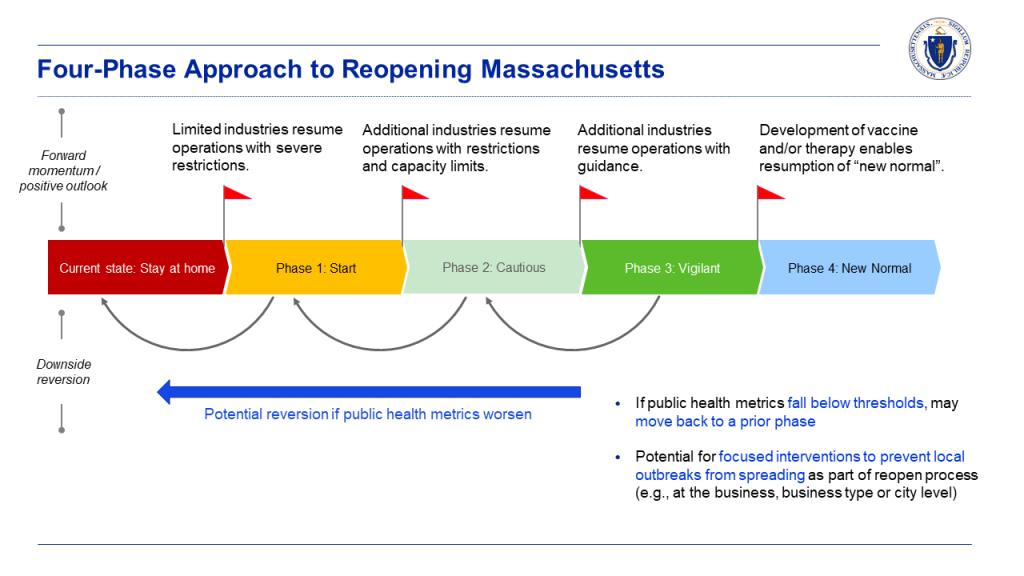BOSTON (WHDH) - Gov. Charlie Baker on Monday announced a four-phase approach to reopening the economy that could begin as early as next week and said that Massachusetts is “trending in the right direction” with regards to key coronavirus statistics that dictate when it will be safe to start taking steps toward a new normal.
RELATED: Some non-essential businesses reopening in New Hampshire amid coronavirus pandemic
About 12,000 COVID-19 tests were administered over the weekend with just 9 percent of individuals testing positive for the virus, Baker said during a news conference at the State House. The state’s COVID-19 hospitalization rate has also dipped to 4 percent.
“That’s obviously a pretty big drop from where we were a month ago,” Baker said. “The weekend’s data represents downward trends across many of our key metrics, which is encouraging…we’re trending in the right direction.”
Baker has repeatedly said that Massachusetts will not begin reopening on May 18 unless his administration has seen a “sustained downward trend” in positive test rates, hospitalization rates, ICU capacity, and fatalities. He added that he would like to “see a few more days” of declining statistics before any decisions are made.
Since Baker announced the formation of the Reopening Advisory Board, members have spoken with associations and community coalitions that represent more 110,000 businesses and more than 10 million workers across Massachusetts.
Over the course of the last week, Baker said the board has met with individuals representing construction, hospitals, dentistry, cultural institutions, sports, art, entertainment, cannabis, fitness, personal care, lifestyle, lodging, banking, tourism, and manufacturing industries. More than 2,200 employers have also submitted written comments and ideas to the advisory board on how to safely reopen.
The board is currently working to develop a reopening plan for higher education, transportation, and childcare.
“The goal is to come up with plans to ensure that we reopen as soon as possible across the many different industries that make up the Massachusetts economy,” Baker said.
The point of the phased reopening, based on public health guidance, is to methodically allow certain businesses, services, and activities to resume while protecting public health and limiting a resurgence of new COVID-19 cases, Baker explained.
The four phases are as follows:
- Phase 1 will be “Start” – limited industries resume operations with severe restrictions
- Phase 2 will be “Cautious” – additional industries resume operations with restrictions and capacity limits
- Phase 3 will be “Vigilant” – additional industries resume operations with guidance
- Phase 4 will be the “New Normal” – development of vaccine and/or therapy enables resumption of new normal
Baker noted that Phase 1 will include industries that are “naturally set up” and have “limited face-to-face interactions.”
It’s not yet clear which businesses and activities will be included in Phase 1 due to expected fluctuations in public health data.
Businesses and activities that have been providing essential services will continue to operate. Certain businesses and activities with a lower risk of COVID-19 transmission will open in earlier phases.
Decisions and timing for when the first phase of reopening begins, as well as when it is safe to move onto concurrent phases, will be influenced by public health metrics, Baker explained.
“Health metrics will determine when Phase 1 start of reopening will begin and when it’s safe to start looking into the concurrent phases after that,” Baker said. “The goal is to begin this process around May 18 but it will be gradual and the facts on the ground will determine whether we actually hit that goal.”
RELATED: Encore Boston Harbor’s reopening plan includes many coronavirus restrictions
The board has also established mandatory workplace safety standards. They are as follows:
Social distancing:
- All persons, including employees, customers, and vendors should remain at least six feet apart to the greatest extent possible, both inside and outside workplaces
- Establish protocols to ensure that employees can practice adequate social distancing
- Provide signage for safe social distancing
- Require face coverings or masks for all employees
Hygiene:
- Provide hand washing capabilities throughout the workplace
- Ensure frequent handwashing by employees and adequate supplies to do so
- Provide regular sanitization of high touch areas, such as workstations, equipment, screens, doorknobs, restrooms throughout the work site
Staffing and operations:
- Provide training for employees regarding the social distancing and hygiene protocols
- Employees who are displaying COVID19-like symptoms do not report to work
- Establish a plan for employees getting ill from COVID-19 at work, and a return-to-work plan
Cleaning and disinfecting:
- Establish and maintain cleaning protocols specific to the business
- When an active employee is diagnosed with COVID-19, cleaning and disinfecting must be performed
- Disinfection of all common surfaces must take place at intervals appropriate to said workplace
Baker urged all residents to continue to stay home, practice social distancing, avoid crowds of 10 or more people, and to wear masks in public.
“This is no time to quit. We have to keep driving, we have to keep following the data, we have to understand and respect the virus,” Baker said. “If we do those things, we will get there.”
The board is scheduled to provide its full report to Baker on Monday, May 18.
Click here for more coronavirus coverage.
(Copyright (c) 2024 Sunbeam Television. All Rights Reserved. This material may not be published, broadcast, rewritten, or redistributed.)

